Drilling a borehole: a complete overview of shock-rope technology
How to provide your own plot and house with enough clean water? Sometimes the simplest answer to this question is the design of the well. If you hire a brigade is expensive, but you have the skills and desire to work hard, you can drill it yourself. The methods by which you can get water from the bowels of Mother Earth are different.
Among them, borehole drilling with a bailer takes a worthy place. Most often, gelation is used in combination with the rotational core method for the extraction of loose, incoherent rocks: sand, gravel deposits. It happens that without the use of a baffle it is generally impossible to raise the destroyed soil from the bottom.
We will talk about how drilling is performed when using a bailer. Here you will learn how to properly drill a water well in a suburban area using the simplest home-made drilling tool. Based on our recommendations, you will be able to equip a source of water with minimal costs.
The content of the article:
General concepts about the drilling process
Drilling with a choke is a so-called shock-rope drilling method. As a drilling tool, a choke is used - a heavy, hollow, long and narrow projectile that is dropped into the well shaft from a height of several meters.
Under the weight of the flap, soil layers are destroyed and fall into the cavity of the projectile. The choke is removed, cleaned of soil, and then thrown back into the mine.
The process is repeated again and again until they reach the aquifer and pass it. Although the process seems simple in the description, it can be long and laborious.
However, shock-rope drilling has many advantages over other methods. For example, in manual drilling using a bailer, usually no water is supplied to the barrel, as is often done with auger or rotary drilling.
As a result, the soil in the well does not get wet, and this reduces the risk of weakening or destruction of its walls. Another plus is the accurate definition of the aquifer.
With wet drilling, it is not always easy to understand that the long-awaited water has finally appeared.Even experienced drillers sometimes do not immediately recognize this moment and continue drilling. In addition, it is believed that the flow rate of “dry” wells is higher than that of “wet” ones.
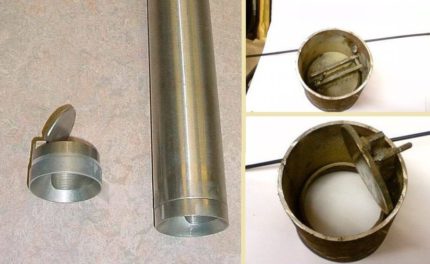
Choosing between the bailer and the screw, some masters are guided by the following considerations. Flushing screw augers, which are produced by modern industry, have restrictions on the depth of drilling.
And the power of such installations is 12 kW. It is difficult to find a gear motor that provides such power in a domestic environment.
But a gearbox with a capacity of only 2.2 kW lifts a load weighing about one ton. Such a mechanism will lift a very heavy bailer without difficulty. It remains only to throw the bouncer down to get a sufficiently strong blow, capable of destroying sufficiently dense rocks. Thus, with less energy consumption, a more effective effect is obtained.
Also collect improvised bailer it will be simpler and faster than a screw, the design of which is noticeably more complicated. There are cases when, with the help of a home-made bailer, tripod and motor, it was possible to break a well with a depth of more than 40 meters, although it took several months to complete this work.
What should be considered when working?
To begin with, it does not hurt to foresee possible problems. Of course, each well has individual characteristics.
Drilling at a distance of only a couple of tens of meters can take place according to a different scenario. But knowledge of the approximate composition of the soil and the layers that it includes will make it possible to draw up a preliminary plan, stock up on necessary tools, etc.
The heavier and more viscous substance you need to remove to the surface, the more difficult it will be to work the bailer. The easiest way to handle dry sand. But work on quicksand can last forever, while the well almost does not deepen. In this case, some masters recommend drilling with simultaneous flushing, immersing the casing as soon as possible ahead of the baffle.
It is almost impossible to overcome heavy clay with a billet. On soils of this type, drilling is more efficiently performed in other ways.
To select a layer of loam, use a glass: a narrow long tool with a sharp lower edge and without a valve. He is also thrown into the mine from a height of several meters. Then the glass is removed and cleaned through a narrow vertical hole made in its side. Sometimes such a hole is made in the bailer.
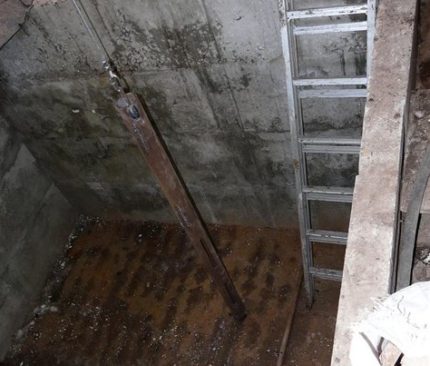
Such loam work is progressing heavily and slowly. It is worth evaluating the cost of labor and time, it may make sense to prefer auger drilling to the shock method. There are two ways to evaluate the composition of the soil on which drilling will be performed.Cheap is to ask neighbors who already have a well, and expensive is to order drilling work from specialists.
Usually, a place is chosen for the well where the relief is lowered; it is believed that this will be closer to the aquifer. Some craftsmen with the help of the bailer managed to drill a pretty decent hole right in the basement of their house, since the machine or tripod for the bailer is a relatively compact structure.
It should be remembered that such work can only be carried out in a fairly spacious basement with a high ceiling. In this space, it is not only to place the drilling rig, but also to perform the extension of the casing.
If the floor and ceiling are not yet available, the winch can be mounted on the rafters. In addition, you should reckon with a lot of dirty water that will come from the well during drilling and can flood everything around. Drilling is wiser to carry out in the dry season.

Most often this is done in the summer. Drilling operations in winter are also quite effective, although overcoming a layer of frozen soil may not be easy. But in the spring during the flood, drilling wells is not recommended. It is more difficult to take out wet soil, and it will be more difficult to determine the moment of appearance of water in the well. In autumn, work usually falls on November.
Tools and materials used
First you need the actual bailer, as well as the installation to which it needs to be suspended. Drill bumper - the shell is quite heavy.
With a strong desire, a filled device can, of course, be pulled out of the mine manually, but this will require a lot of time and effort. To facilitate the work, the drilling site is installed tripod tower.
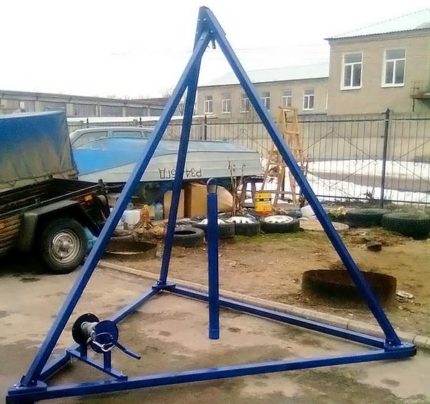
It can be made of metal or wood. At the top, a block is fixed through which a metal cable is passed. A bobbin is suspended on this cable. So it will take less effort to pull it out.
The lifting is performed using a gear motor with a clutch, on the shaft of which a cable is wound. To prevent the drum from spinning due to inertia after the impact of the bailer, a special device for braking can be installed.
For commercial use, the use of the brake is justified, but for your own needs you can do without it. Using the clutch, you can adjust the force supplied to the device, taking into account the moment of impact. In the process of operation of the device, the ability to determine this moment quickly comes with experience.
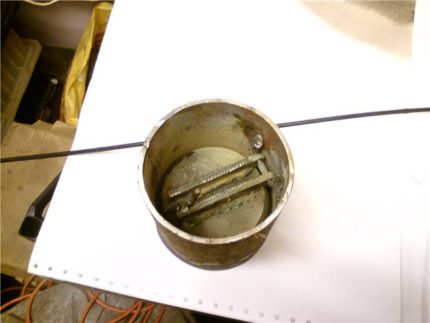
And the installation, and bouncer, and a glass can be made independently or purchased in hardware stores. On how to make a drilling tool for manual drilling, it is written in detail in this article.
For the manufacture of baits you will need a piece of metal pipe several meters long. The outer diameter of such a pipe should be less than the inner diameter of the casing by about 20 mm. For example, if a 133 mm steel casing is used, a pipe with a diameter of 108 mm is suitable for a wave bobbin.
The wall thickness of the pipe for the bobbin can reach 10 mm. In this case, the dimensions and weight of the device should be correlated. It must be heavy enough so that when it hits the ground, it can be loosened and grasped effectively.
But it should be remembered that for pulling out the filled flap, the power of the gearbox must be enough. It is considered sufficient weight of 30-40 kg. When the pipe is selected, it is necessary to weld or screw the shoe with the flap valve down.
At the top, a protective grill and a handle are welded to which a metal cable should be attached. The lower part can be sharpened inward to improve soil loosening. Instead of sharpening the edges, you can weld pointed rods or sharp pieces of metal below.
In approximately the same way, a glass is made from a piece of pipe for drilling a well on loams. Only in this case, the valve is not needed, and vertical holes are made along the length of the pipe so that the glass can be cleaned of viscous soil.
In addition to the installation and bailer, you will need a number of materials and devices:
- casing in the right amount;
- clamps to fix pipes during welding or soldering;
- garden drill;
- a place for collecting waste soil;
- a container or place for draining contaminated water;
- welding machine or soldering iron for PVC pipes.
In the formation of the wellbore, you can use both metal and plastic casing. The lower part of the first plastic pipe should be equipped with a special shoe, which facilitates the process of lowering the pipe into the well shaft. Plastic pipes are soldered using a soldering iron designed for this purpose.
It’s easy to learn how to use this tool, but before starting work, it’s better to take a few lessons from more experienced craftsmen or practice on pieces of unnecessary pipes. Working with metal pipes is a little easier, as they are stronger than plastic structures.
Often, such a pipe is simply driven into a shaft to lower it to the desired depth. To weld metal pipes, a welding machine is used, if there is no skill with such equipment, they will have to be mastered. Most often, threaded pipes are used for wells, but welding is considered more reliable.
Description of drilling technology
If all the materials and tools have been prepared, you can start work. A tripod is installed above the selected location for the well. A metal cable of the bobbin is put on the block, and wound it on the gearbox shaft. Using a garden drill, a hole of such a diameter is made in the soil under the bailer so that the bailer passes through it.
You can start drilling. The choke raised above the hole is simply thrown down. The impact loosens the soil, the valve opens, and the cavity of the bunker is filled with soil.
Usually they do not one, but three or four strokes, so that the bollard is filled with soil as much as possible. Then it is lifted up from the shaft, the valve is opened and the captured soil is poured out of the device.
The emptied bailer is again thrown into the shaft several times, etc. Gradually, the mine becomes deeper. To protect its walls from collapse, you must lower the first casing pipe inside.

The pipe is held with special clamps so that it does not sink too deep. As necessary, the length of the casing pipe is increased by welding, screwing or soldering pipes to each other.
It is believed that a shallow well can be drilled first, and then pipes installed, but it is much more reasonable to install pipes immediately. This will precisely prevent the walls of the well from collapsing.
It is very important to correctly install the first casing in the shaft. Her position is set according to the level and carefully recorded. The position of the remaining pipes is set along the first pipe. If the pipe is skewed from the very beginning, this can make it difficult to drill, install a filter pump, maintain a well, etc.
The top layer of loamy soil is usually very dense due to the large number of clay inclusions. It passes through a glass, the device of which is described above. They act in the same way as a bailer: they throw it into the mine, remove it, clean it, etc. After going through this difficult area, you can again use the bailer.
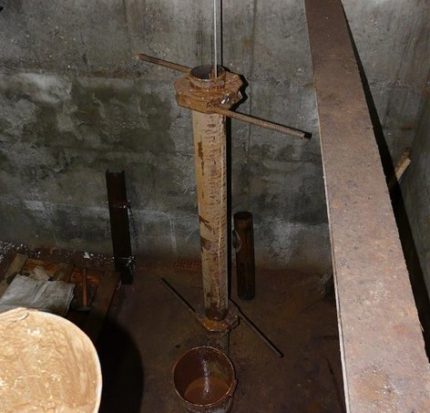
Difficulties can arise during the passage of quicksand, if during drilling the trunk goes through this layer rich in water. Some masters believe that to speed up the work, it makes sense to feed water into the casing and scoop up liquid soil.
Usually, drilling with a bailer is carried out “dry”. This allows you to accurately determine the appearance of water in the well, indicating that the aquifer is reached.
Stopping drilling as soon as water appears in the mine is a common mistake of novice drillers. It is recommended to continue drilling and go deeper into the next layer of soil by about half a meter. Thus, the maximum production rate of the well will be ensured. Then stays pump a well, lower the pump into it, equip the head, etc.
Choice: with or without filter?
To prevent contaminants from entering the well, a second pipe with downhole filter. It is made from a long section of pipe, the diameter of which should be less than the diameter of the casing. The upper part of the pipe is used as an oil seal, and many holes are made in the middle part.
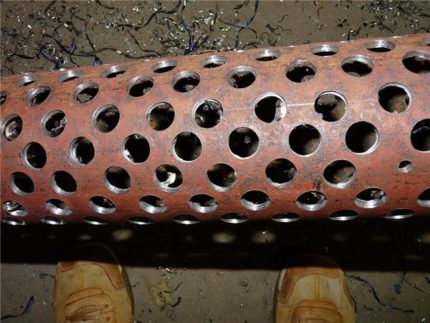
The perforated area is covered with a grid of galunny weaving, but in an extreme case, an ordinary fine-mesh mesh, for example, with parameters 0.2X0.13, is also suitable. The grid can be fixed with wire.
The lower part of the filter is a settler; there, perforation is not needed. If a filter can be lowered into a well arranged with a screw method using interconnected rods, then when performing shock-rope drilling, the filter is delivered using a metal cable.
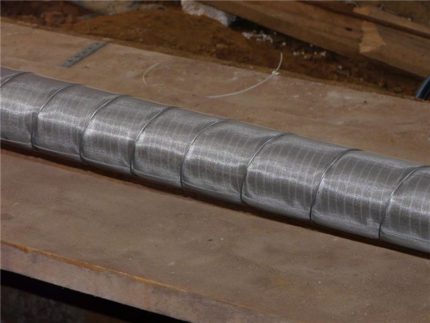
This does not allow the filter to be pressed with force in order to ensure the tightness of the structure when connected to the gland. In this case, it is possible to effectively use PSUL - pre-compressed sealing tape. This material is widely used in the installation of PVC windows.
Such a tape should be wound on the edge of the filter and immediately lowered into the shaft, since the PSUL expands quite quickly. If the filter is lowered immediately after winding the tape, it will expand at the bottom and provide reliable sealing of the filter. After the filter is lowered down, the casing is carefully lifted up.
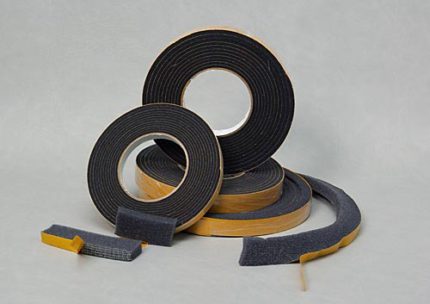
In this case, most of the filter should be below the level of the edge of the casing. Two five-ton jacks can be used to lift the pipe. The part of the pipe removed to the surface is cut off or unscrewed. So that the clamp does not slip, pieces of reinforcement are welded to the protruding piece of pipe.
Shock-rope drilling method allows you to create a filterless well. To equip it in this way, it is necessary to lower the casing below the aquifer by about 0.5 meters. When wet auger or core drilling is difficult to extract core from the well. The bailer easily extracts loose, water-saturated clastic rocks.
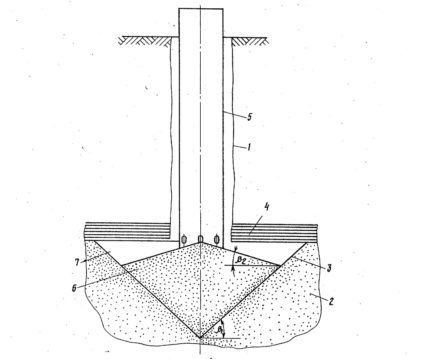
After the casing is firmly installed, two hoses are lowered into the well. In one of them, a stream of water is fed into the well, and in the second, air is pumped with a compressor. Thus, the so-called airlift is obtained, and the flow of water prevents the formation of a sand cork.
As a result, a mixture of water, sand and air will pass through the casing, which must be drained into a separate container. When the mixture settles, the volume of sand washed from the well should be measured. According to the reference books, each cubic meter of such sand is equal to approximately 4.5 cubic meters of flow rate.
Introduces the core and screw method of drilling a water well another article, which we advise you to familiarize yourself with.
Conclusions and useful video on the topic
Video # 1. Visual demonstration of the drilling of a borehole with a chipper:
Video # 2. The combination of auger drilling on hard ground and the use of a bailer to pass fine water-saturated sand:
Video # 3. An interesting version of the device of the chipper and the glass for drilling:
Shock-rope drilling has many advantages over the more common auger method. The bailer and other devices are easy to make from improvised materials. The drilling process is also simple, especially if possible problems are foreseen at the very beginning.
Do you have personal experience in manual drilling? There were questions during the familiarization with the material presented by us, do you want to share only the details you know? Please write comments in the block below, ask questions, leave a photo on the topic.

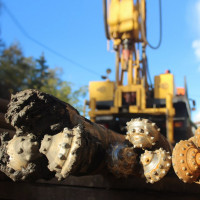 Rotary Well Drilling: An Overview of Drilling Technology and Essential Equipment
Rotary Well Drilling: An Overview of Drilling Technology and Essential Equipment 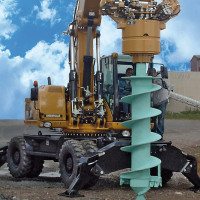 Auger drilling of wells: features of technology and shell for manual drilling and installation
Auger drilling of wells: features of technology and shell for manual drilling and installation 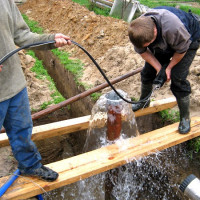 Do-it-yourself flushing of the well after drilling: step-by-step briefing on the work
Do-it-yourself flushing of the well after drilling: step-by-step briefing on the work  Do-it-yourself water-boring for water wells: a review of technology
Do-it-yourself water-boring for water wells: a review of technology  Do-it-yourself well cleaning: a review of common clogging causes and best cleaning methods
Do-it-yourself well cleaning: a review of common clogging causes and best cleaning methods 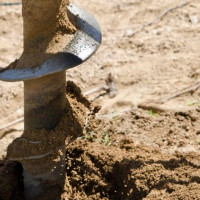 How to punch a well into water: options and drilling technologies that are in demand in practice
How to punch a well into water: options and drilling technologies that are in demand in practice  How much does it cost to connect gas to a private house: the price of organizing gas supply
How much does it cost to connect gas to a private house: the price of organizing gas supply  The best washing machines with dryer: model rating and customer tips
The best washing machines with dryer: model rating and customer tips  What is the color temperature of light and the nuances of choosing the temperature of the lamps to suit your needs
What is the color temperature of light and the nuances of choosing the temperature of the lamps to suit your needs  Replacement of a geyser in an apartment: replacement paperwork + basic norms and requirements
Replacement of a geyser in an apartment: replacement paperwork + basic norms and requirements
The most difficult with this method of drilling a well is considered to break through the limestone, if it gets into clean water. The first 6-8 meters are easy enough (loam, sand, sandy loam), and then the most interesting. Through limestone or slate, you can fight all day, but in the end you will provide yourself with excellent quality water without turbidity and sand (which comes in a shallow sandy layer).